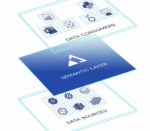Business intelligence and reporting solutions are available in both commercial and open-source versions. While many businesses have needs that can only be satisfied by using commercial business intelligence and reporting solutions, others would do perfectly well by sticking with open-source solutions. Here are some pros and cons of using open-source ones:
PRO #1: Connecting to Big Data sources can be done equally as well with open source.
Just as in commercial versions, many open-source versions let you connect natively to a lot of Big Data formats. “We provide low-latency or very high-velocity access to otherwise difficult-to-access data types like Mongo and Cassandra and Hadoop and so on,” said Brian Gentile, CEO of Jaspersoft. “The connectors and the linkages to all these different data types are consistent across our open-source or ‘community’ editions, and our commercial editions.”
The difference comes at the higher layers of the software where there are more features in commercial versions, Gentile said. “You can simply do more with Big Data in our commercial versions,” he said. “But you can report on it very nicely with our open-source editions because the connections and the connection technology is identical.”
CON #1: With open source, fewer features are included.
When deciding between commercial and open-source solutions, keep in mind that the open-source version will not contain as many features. “Frankly, a lot of people can start off with open source, it just depends on what their needs are,” said Richard Daley, CEO of Pentaho. “But in our enterprise version, for example, there’s richer interactive reporting, richer visualizations, and better, if you will, ways to go through and even interact with some of the Big Data sources than in the open-source version.”
So the No. 1 reason to consider a commercial product over an open-source one would be this feature distinction. “A developer would need the extra features that are put into commercial versions,” said Gentile. “We have five products that make up the commercial version of our software, and each of them has an open-source counterpart. But in every case, they have fewer features than their commercial counterparts.”
PRO #2: Internationalization and localization are also supported in open source.
Like commercial business intelligence solutions, open-source solutions support internationalization and localization for a variety of languages. “Our open-source editions support about 50 languages, including English, French, Spanish, Italian, German, Chinese and Japanese,” Gentile said.
The open-source Eclipse BIRT project, which Actuate co-leads, supports about 30 languages. “This is actually what IBM contributed to the Eclipse BIRT project, the capability to do very easy and rapid internationalization,” said Nobby Akiha, senior VP of marketing at Actuate.
#!
CON #2: Due to licensing restrictions, embedded business intelligence is trickier to do with open source.
If you need to embed some business intelligence technology into your own software, be aware that it’s not as easy to do if you’re using an open-source business intelligence solution. Licenses and their restrictions are the reasons why developers might need to stay with a commercial business intelligence solution. “The truth is, an open-source license like we have chosen—the GPL license or the LGPL license—does have restrictions. You can’t just do anything that you want with it,” Gentile said.
For instance, with the GPL license, you would not be able to embed that software into your software and then resell it for commercial gain, he said, without putting all of your software back into open source. “So there are restrictions within the open-source licenses that would prevent someone from completely using the open-source tool in an embedded scenario.”
PRO #3: There are no big perpetual licensing fees or subscriptions with open source.
Commercial business intelligence and reporting solutions are available either by subscription or through perpetual licensing, whereas open-source solutions are free.
CON #3: There’s less direct product support with open source.
Open-source versions offer less support if you run into problems. Developers who really want direct support from, and interaction with, vendors should stick to commercial versions.
If the open-source version of a business intelligence solution has enough features, and you’re comfortable with the license requirements, then the open-source version could be all you would need. “That’s why we, for example, have 16 million downloads and 300,000 registered community members, because there’s a ton of people out there who are perfectly fine with an open-source edition,” Gentile said.





